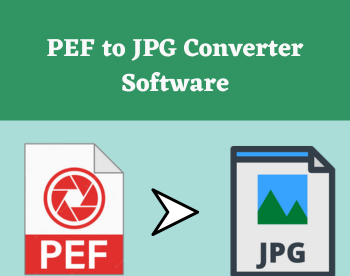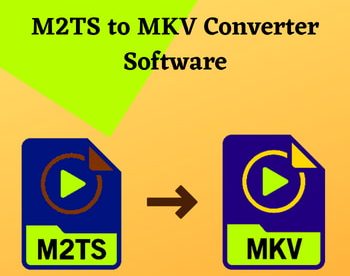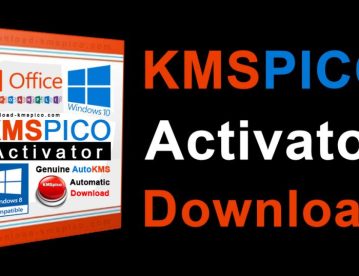4 Best Free Open Source Audio Noise Reduction Software For Windows
Here is a list of best free open source audio noise reduction software for Windows. These software are similar to standard noise reduction software that detect and remove noise from an audio file. Plus, the source code of all these software is freely available. Anyone can download and edit the source code of these software without any restriction.
To remove or reduce noise from an audio file, these software come with a noise reduction tool. This tool detects the noise present in an audio file and then removes the frequency range that contains the noise. In a few software, you can even specify the exact noise reduction value in decibel to remove noise. Plus, some software can also remove noise from input sound signals of microphones and MIDI devices. The process to remove noise from audio is quite simple in all these software. Still, to help novice users, I have included the necessary noise removal steps in the description of each software.
Apart from audio noise reduction, these software can also be used to edit input audio files. To edit audio, some software comes with many editing tools like timeline editor, audio effects, audio cutting tools, and more. I also like the ability of these software to support audio of various formats like MP3, WAV, OGG, AAC, and more. After audio noise reduction and audio editing process, users can also export the final audio in one of many supported audio formats. Go through the list to know more about these apps.
My Favorite Open Source Audio Noise Reduction Software For Windows:
Audacity is my favorite software because it can generate a noise profile of an audio file. Plus, it also allows users to manually specify the exact noise reduction value according to t their requirements.
You can also check out lists of best free Audio Noise Reduction, Open Source MKV Editor, and Open Source Audio Recorder software for Windows.
Audacity
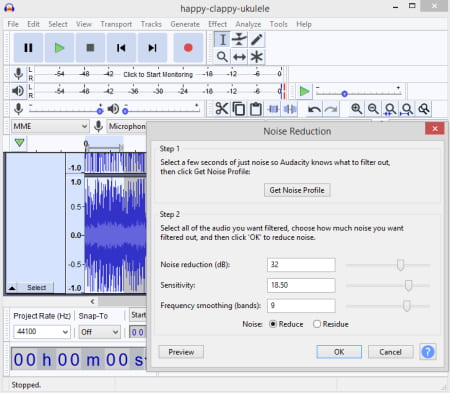
Audacity is a free open source audio noise reduction software for Windows, macOS, and Linux. It is primarily an audio editing software through which users can perform various audio editing operations such as audio recording, audio mixing, audio cutting, and more. It also offers a lot of audio effects and filters that users can try to make desired changes to the audio. I also like its ability to support audio files of various formats like MP3, WAV, OGG, FLAC, AIFF, etc. Now, to reduce audio noise, it offers a dedicated Noise Reduction tool. Using this tool, users can generate a noise profile for an input audio file and then specify the noise reduction values to remove noise from an audio file. Now, follow the below steps to remove noise from audio using this software.
How to reduce noise from audio using Audacity:
- Start this software and go to File > Open option to load an audio file.
- After that, select a specific area of the audio or entire audio timeline from its timeline editor.
- Next, go to Effects and choose the Noise Reduction option.
- Now, click on the Get Noise Profile button and then manually specify noise reduction, sensitivity, and frequency smoothing values.
- In the end, press the OK button to start the noise reduction process.
After removing the noise from an audio file users can save it in MP3, WAV, OGG, etc., audio file formats.
Additional Features:
- Effects: This software offers many advanced audio effects such as Fade In, Fade Out, Invert, Normalize, Limiter, Sliding Stretch, and more.
- Analysis Tools: It also offers multiple audio analysis tools such as Plot Spectrum, Find Clipping, Beat Finder, and more.
- Audio Generator: In this software, users can also generate various tones and sounds such as Chirps, DTMF Tones, Noise, and more.
Final Thoughts:
It is one of the best free open source audio noise reduction software because it allows users to manually specify the exact noise reduction values.
dsp_chung
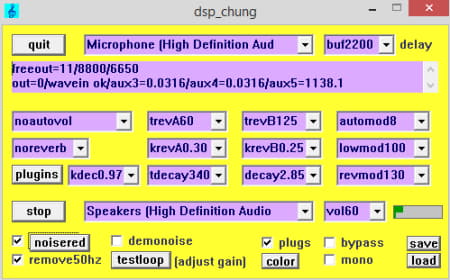
dsp_chung is a free open source audio noise reduction software for Windows. Through this software, users can remove noise from input audio devices like microphones, MIDI devices, etc. Besides this, it can also be used as DSP or digital signal processing software. It also comes with various audio effects and audio tools that users can use during the recording to make necessary changes to input audio signals. Now, follow the below steps to remove noise from input audio using this open source software.
How to remove noise from audio using dsp_chung:
- Launch this software and select the input audio device from the device menu.
- Next, specify the delay, input volume, and audio effects that you want to apply over the input audio.
- After that, enable the noisered option to actively reduce the noise present in the input audio signal.
- Lastly, run a test loop and then click on the Save button.
Additional Feature:
- Plugins: In this software, users can add various third-party plugins to add new features to this software.
Final Thoughts:
It is another good open source audio noise reduction software through which users can reduce noise from input audio signals.
WAV Speech Enhancer
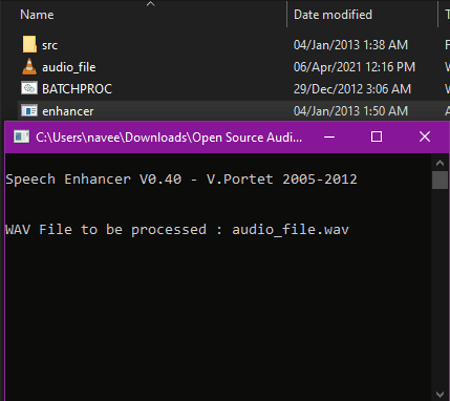
WAV Speech Enhancer is another free open source audio noise reduction software for Windows. Through this software, users can improve the signal-to-noise ratio by removing the noise from an audio file. This software is programmed to remove the Pink noise that falls between 50 to 60 HZ range. Unlike other similar software, it doesn’t come with a graphical user interface, thus users need to use the command line to run this software. Now, follow the below steps to remove noise from audio using this software.
How to remove noise from audio using WAV Speech Enhancer:
- First copy a WAV audio file from which you want to remove the audio and paste it to the main folder of this software.
- After that, launch this software in the command line.
- Lastly, enter the name of the input audio file with its extension in the command line and hit enter button to start the noise removal process.
Limitations:
- This software only supports WAV audio files.
- It doesn’t come with a graphical user interface.
Final Thoughts:
It is another good open source audio noise reduction software through which users can quickly remove noise from WAV audio files.
AudioMass
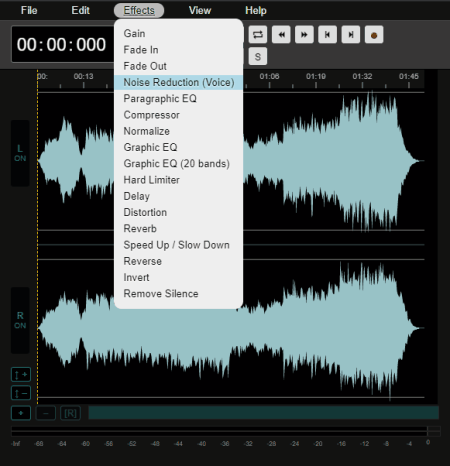
AudioMass is a free open source audio noise reduction service. It is an online service through which users can remove noise from an audio file. It also comes with a software version that users can run on Python. In this service, users can load audio files of various formats like WAV, MP3, AAC, and more. Plus, various audio editing tools and effects are also present in it to make desired changes to an audio file. Now, follow the below steps to remove noise from audio using this open source online service.
How to remove noise from audio using AudioMass:
- Go to this service and then go to File > Load from computer option to browse and load an audio file.
- After that, select some part of the audio or entire audio timeline using its timeline editor.
- Now, go to Effects and choose the Noise Reduction option to immediately reduce the noise from the audio.
- In the end, go to the File > Export option to export the audio in MP3 or WAV audio format.
Additional Features:
- Analysis Tools: This service offers multiple tools to analyze the frequency, spectrum, and other aspects of an audio file.
- ID3 Tags: It is another handy tool through which users can view information about input audio such as Artist Name, Album Name, Track, Comment, Genre, etc.
Final Thoughts:
It is another capable open source audio noise reduction service through which users can quickly reduce noise from an audio file.
Naveen Kushwaha
Passionate about tech and science, always look for new tech solutions that can help me and others.
About Us
We are the team behind some of the most popular tech blogs, like: I LoveFree Software and Windows 8 Freeware.
More About UsArchives
- May 2024
- April 2024
- March 2024
- February 2024
- January 2024
- December 2023
- November 2023
- October 2023
- September 2023
- August 2023
- July 2023
- June 2023
- May 2023
- April 2023
- March 2023
- February 2023
- January 2023
- December 2022
- November 2022
- October 2022
- September 2022
- August 2022
- July 2022
- June 2022
- May 2022
- April 2022
- March 2022
- February 2022
- January 2022
- December 2021
- November 2021
- October 2021
- September 2021
- August 2021
- July 2021
- June 2021
- May 2021
- April 2021
- March 2021
- February 2021
- January 2021
- December 2020
- November 2020
- October 2020
- September 2020
- August 2020
- July 2020
- June 2020
- May 2020
- April 2020
- March 2020
- February 2020
- January 2020
- December 2019
- November 2019
- October 2019
- September 2019
- August 2019
- July 2019
- June 2019
- May 2019
- April 2019
- March 2019
- February 2019
- January 2019
- December 2018
- November 2018
- October 2018
- September 2018
- August 2018
- July 2018
- June 2018
- May 2018
- April 2018
- March 2018
- February 2018
- January 2018
- December 2017
- November 2017
- October 2017
- September 2017
- August 2017
- July 2017
- June 2017
- May 2017
- April 2017
- March 2017
- February 2017
- January 2017
- December 2016
- November 2016
- October 2016
- September 2016
- August 2016
- July 2016
- June 2016
- May 2016
- April 2016
- March 2016
- February 2016
- January 2016
- December 2015
- November 2015
- October 2015
- September 2015
- August 2015
- July 2015
- June 2015
- May 2015
- April 2015
- March 2015
- February 2015
- January 2015
- December 2014
- November 2014
- October 2014
- September 2014
- August 2014
- July 2014
- June 2014
- May 2014
- April 2014
- March 2014
